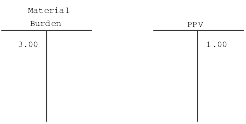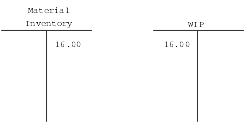7 Understanding Calculations in Cost Rollup
This chapter provides information on how the system generates hard-coded cost components in the cost rollup process. These calculations can vary according to the settings in the manufacturing constants and processing options.
This chapter contains the following topics:
7.1 Simulated Cost Rollup
The Cost Simulation program (R30812) adjusts direct labor hours and direct machine hours by time basis, crew size, and cumulative yield, as appropriate. The program adjusts component material quantities by operation scrap and percent scrap.
7.2 Material Cost Components
This table illustrates how the material cost components A1 and A2 reflect the cost that is incurred from purchased material and from material scrap:
7.3 Routing Cost Components
Routing cost components (cost components B and C) can be controlled manually or through the Simulate Rollup program (R30812).
This section discusses:
-
B1 (direct labor).
-
B2 (setup labor).
-
B3 (machine run).
-
B4 (labor efficiency).
-
C1, C2 (variable and fixed machine overhead).
-
C3, C4 (variable and fixed labor overhead).
7.3.1 B1 (Direct Labor)
B1 costs can be calculated as:
-
Parent direct labor costs = sum of direct labor calculations for all operations on the item's routing.
-
(Operation direct labor cost) = ((operation direct labor hours ÷ operation time basis) × (operation crew size) ÷ (operation cumulative yield percent ÷ 100)) × (work center direct labor rate)
7.3.2 B2 (Setup Labor)
B2 costs can be calculated as:
-
Parent setup labor cost = sum of all setup labor calculations for all operations on the item's routing
-
Operation setup labor cost = (operation setup labor hours) × (work center setup labor rate) ÷ (accounting cost quantity)
Note:
Divide the work center setup labor rate only if the accounting cost quantity is not zero.
7.3.3 B3 (Machine Run)
B3 costs can be calculated as:
-
Parent machine run cost = sum of machine run calculations for all operations on the item's routing
-
(Operation machine run cost) = ((operation machine run hours ÷ operation time basis) ÷ (operation cumulative yield ÷100)) × (work center machine run rate)
7.3.4 B4 (Labor Efficiency)
This cost component increases or decreases the cost of the labor that is required to produce an item. If you have set the manufacturing constants to modify costs by work center efficiency, the program creates a cost component (B4) for labor efficiency when you run the Simulate Rollup program. In addition, if the efficiency for a work center is equal to zero, the system does not perform a calculation for that work center.
The system calculates labor efficiency only for direct labor hours as:
Parent labor efficiency cost = sum of all efficiency calculations for all operations on the item's routing
Calculating the operation labor efficiency cost requires these calculations:
-
(Direct labor hours) × (time basis code) ÷ ((crew size) ÷ operation yield percent)) = (factored labor hours)
-
(Work center efficiency) ÷ (percentage conversion) × (factored labor hours) = Factored efficiency hours
-
Labor efficiency cost = (factored labor hours − (factored efficiency)) × (direct labor rate)
7.3.5 C1, C2 (Variable and Fixed Machine Overhead)
The system calculates C1 and C2 costs only if you have set the manufacturing constants for the branch/plant to include variable and fixed machine overhead in the cost. You must also specify whether you want the system to calculate machine overhead costs from manually entered rates in the Work Center Master table (F30006) or as a percent of machine run costs.
Parent variable and fixed machine overhead cost is the sum of all variable and fixed machine overhead calculations for the item's routing.
Calculating variable machine overhead costs requires these calculations:
-
(Machine variable labor overhead percent) ÷ (percentage conversion) × (machine run rate) = (variable machine overhead rate)
-
(Machine run hours) ÷ (time basis code ÷ (operation yield percent)) = (variable machine overhead run hours)
-
(Machine variable overhead cost) = (variable machine overhead run hours) × (variable machine overhead run rate)
Calculating fixed machine overhead costs requires these calculations:
-
(Machine fixed labor overhead percent) ÷ (percentage conversion) × (machine run rate) = (fixed machine overhead rate)
-
(Machine run hours) ÷ (time basis code) ÷ (operation yield percent) ÷ (primary UOM conversion factor) = (fixed machine overhead run hours)
-
(Machine fixed overhead cost) = (fixed machine overhead run hours) × (fixed machine overhead run rate)
7.3.6 C3, C4 (Variable and Fixed Labor Overhead)
The system displays these calculations as rates. If you indicate on the Work Center Master Revisions form that variable and fixed labor overhead costs should be calculated as a percent of labor costs, multiply the work center labor rate by the percent divided by 100 to obtain the labor overhead rate. For example:
(Operation variable labor overhead rate) = (work center variable labor overhead percent) ÷ (100) × (work center direct labor rate)
These costs are calculated only if you have set the manufacturing constants for the branch/plant to include variable and fixed labor overhead in the cost. In this table, you must also determine whether labor overhead costs are calculated from manually entered rates in the Work Center Master table (F30006) or as a percent of labor costs.
In addition, you can set the manufacturing constants to factor labor overhead by work center efficiency:
-
Parent variable and fixed labor overhead cost = sum of all variable and fixed- labor overhead calculations for all operations on the item's routing.
-
(Variable and fixed labor overhead cost) = (direct labor overhead cost) + (setup labor overhead cost)
Direct labor overhead cost by rate:
-
Without labor efficiency: (direct labor hours) × (work center variable and fixed labor overhead rate)
-
With labor efficiency: (direct labor hours + work center efficiency) × work center variable and fixed labor overhead rate
-
-
(Work center efficiency) = (labor hours) − ((work center efficiency percent) ÷ (100)) × (labor hours)
-
(Setup labor overhead cost by rate) = (operation setup labor hours ÷ accounting cost quantity) × (work center variable and fixed labor overhead rate)
Accounting cost quantity is factored if it is not equal to zero.
7.4 Outside Operation Cost Components
You can manually enter cost components for outside operations on the Enter Cost Components form (W30026B) or let the system retrieve them from the Item Cost table (F4105) when you run the Simulate Rollup program (R30812).
The Order Processing program (R31410) creates item numbers for outside operations where Parent represents the parent item number, and xx represents the whole-number portion of the operation sequence number of the outside operation:
Parent*Opxx
For example, for item 333, an outside operation at operation sequence number 30 receives an item number of 333*OP30.
If you enter a cost method in the Outside Operations processing option for the Simulate Rollup program, the program uses that cost method to retrieve the cost from the F4105 table. If the value is zero, and a value previously existed in the Item Cost Component Add-Ons table (F30026), the original value remains. If you leave the processing option blank, the program uses the values that you manually entered on the Enter Cost Components form.
7.5 Purchase Price Variance
For purchased items, a purchase price variance (PPV) results when the standard cost differs from the actual purchase price. If you use extra costs on purchased items, the total standard cost might differ from the A1 (material) cost. This difference is the material burden cost.
When you receive a purchase order, the system updates the accounts payable account using the price on the purchase order. The system updates the inventory account with the standard item cost from the F4105 table. Any difference between the two costs is made up of PPV and material burden. PPV is the difference between the frozen A1 cost and the purchase order cost.
Material burden cost is the difference between the total standard cost from the F4105 table and the A1 cost:
-
PPV = (A1 cost) − (purchase order unit cost)
-
Material burden cost = (total standard cost) − (A1 cost)
7.5.1 Example: Purchase Price Variance and Material Burden
The Item Cost table (F4105) includes this information:
-
Average cost = 14.00
-
Standard cost = 16.00
The Item Cost Component Add-Ons table (F30026) includes:
-
A1 cost = 13.00
-
X1 cost = 3.00
These t-account graphs illustrate the accounting flow for price variance and material burden:
Figure 7-1 T-account for price variance and material burden

Description of "Figure 7-1 T-account for price variance and material burden"
This T-account graph illustrates how material that is issued to the work order relieves the inventory account and posts to the work-in-process (WIP) account with the fully loaded standard cost for the item:
Figure 7-2 T-account for material inventory and WIP

Description of "Figure 7-2 T-account for material inventory and WIP"
This t-account graph illustrates that at period end, a manual journal entry closes the PPV to the Cost of Goods Sold account:
AAI table 4337 posts the material overhead. If you have multiple cost extras and you want to post to different accounts for each of them, you must use landed cost.
